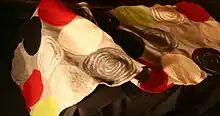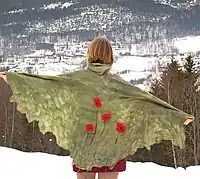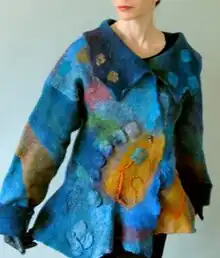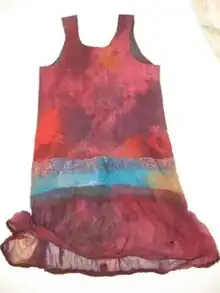


Nuno felting is a fabric felting technique developed by Polly Stirling, a fiber artist from New South Wales, Australia, around 1992. The name "Nuno" is derives from Japanese (布) and means cloth.[1]
Technique
The technique used in Nuno felting bonds loose fiber (usually sheep's wool) into a sheer fabric, such as silk gauze, creating a lightweight felt. Other fibers are also used to create different surface textures. Other fibers used include wool from camel, llama, alpaca, Mohair goat, Cashmere goat, yak, and rabbit fur.
Those fibers can completely cover the background fabric, or they may be used as a decorative design that allows the backing fabric to show. Nuno felting often combines several layers of loose fibers to build up the finished fabric color, texture, and design elements.
The felting process is particularly suitable for creating lightweight fabrics used to make clothing. The use of silk or other stable fabric in the felt creates a fabric that will not stretch out of shape. Fabrics such as nylon, muslin, or other open weaves can be used as the felting background, which results in varying textures and colors.

Nuno felting creates a highly versatile fabric. It can be made in many weights to accommodate many different uses. It can be made much lighter in weight than traditional all-wool felt, accounting for its movement and drape. Because of the range of weights possible with the cloth very diverse garments can be made.
A lightweight Nuno fabric is made by laying one layer of loose fiber onto an open weave fabric base, creating a lightweight material. A much heavier Nuno fabric results from applying more layers, usually 3-4, of loose fibers onto an open weave base creating fabric ideal for a winter coat or scarf.



References
- ↑ Ziek, B. (2004). The felt frontier: I: Polly Stirling: Contemporary feltmaker. Surface Design Journal, 28(4), 35-38
Giles, Jenne (2010). "Felt Fashion" Quarry Books., MA ISBN 978-1-59253-608-5
White, Christine (2007)."Uniquely Felt" Storey Publishing, MA ISBN 978-1-58017-673-6